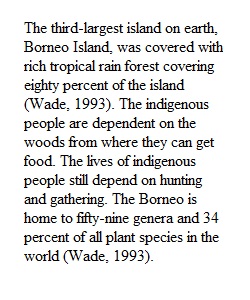


Q For this Final Project 1 I would like you to start by reading the article linked to above, titled ‘Societies in Danger.’ It was written in 1993 by Wade Davis, a Canadian ethnobotanist and anthropologist, and it documents the struggle of the Dayak people over logging and deforestation in their homeland. Next please follow the second link to the website called ‘The Borneo Project,” dedicated to supporting the indigenous communities in Borneo. Keep in mind that almost 25 years separates these two parts of the story. Please explore the website to familiarize yourself with the history of the region and its people struggle to preserve their communities and to learn about the mission and the goals of the project. Make sure also to follow the website’s links to the short documentaries on deforestation and dams in Borneo. For this project, please write a 4 to 5 page essay on the struggle of the indigenous communities in Borneo. Throughout your essay, please make an effort to focus on the themes of globalization that we have encountered in the course readings and discussions – economic globalization and corporate rule, labor and displacement of indigenous communities, environmental destruction and human rights. Your write-up should combine a summary of some key events and struggle, but also bring to the fore your analysis of the global processes that frame those struggles and make explicit the connections to global structures that thwart or enable the communities’ and the Borneo Project’s successes.
View Related Questions